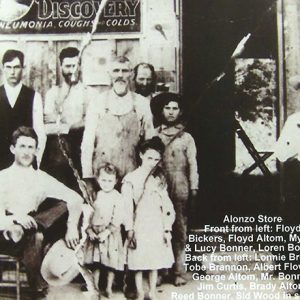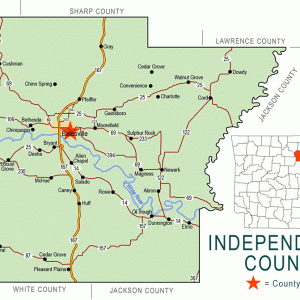calsfoundation@cals.org
Cedar Grove (Independence County) [Southwest]
There are two communities named Cedar Grove in Independence County—one south of the White River near Floral (Independence County) and Pleasant Plains (Independence County), and the other north of the White River near Charlotte (Independence County) and Cave City (Sharp and Independence counties). This has led to much confusion, as each one has a Cedar Grove Cemetery. The two locations are often confused on the Internet as well. Both are historical communities dating back to before the Civil War, and both are said to take their names from clusters of cedar trees found in the areas where log homes were built by early settlers.
Cedar Grove in the southwestern part of the county lies on Highway 87 (Floral Road) between Floral and Pleasant Plains in Liberty Township, fourteen miles south-southwest of Batesville (Independence County). Cedar Grove was first known as Big Creek and then as Alonzo. It was one of several small communities located in the Floral and Pleasant Plains area, including Bailey (Independence County), Pine Grove (Independence County), Starnes Spring (Independence County), and Banner (Cleburne County). Nearby in White County were Davenport and Tyler, which no longer exist.
Pre-Columbian mound builders from the White River valley may have hunted in the area. Evidence indicates that the later Quapaw used the woods for hunting and gathering during the Spanish and French colonial eras. Quapaw chief Tahkodah lived in the area and is believed to have died along Salado Creek. Camp Tahkodah on Salado Creek, owned by Harding University in Searcy (White County), was named in his honor when it was established in 1931 by L. R. Sessions. Camp Tahkodah Road also bears his name.
Early white settlers were in the area by 1842, when a post office was established at Pleasant Plains. The main wagon road of travel was the Jackson Military Road, which paralleled the old Southwest Trail. The Cedar Grove community, first known as Big Creek, was sparsely populated with hunters and trappers and a few farmers before the Civil War. The war brought refugee farmers and ranchers from southern states, particularly Alabama, to the area. The hilly landscape was suitable for small farms and for raising livestock such as cattle.
During the Civil War, lawless bands roamed the hills and hollers of north-central Arkansas. In the Cedar Grove community, shortly after secession, the Reverend James Wimberly Murray, a Methodist Episcopal minister, was shot to death in his front yard, accused of being an abolitionist. Murray is said to have been the first person buried in the Mount Zion Cemetery in the Banner community near Cedar Grove.
The first medical doctor in the region lived in Cedar Grove. Dr. Sterling Wesley (S. W.) Allen, born in Wilson County, Tennessee, married Malissa Carter in Carroll County, Tennessee, in 1850, and the couple lived on Big Creek with two daughters by the 1860 census. Allen was a typical frontier doctor, traveling by horse and buggy to tend to patients.
During Reconstruction, an influx of young, industrious farmers and ranchers resulted in a turn-of-the-century boom for the area, with the Pearson, Wilf, Wilcox, Altom, Alton, Brown, Deloach, Frazier, Bickers, Wood, Gay, Brannon, Bonner, and Thomas families playing leading roles. Tobe Pearson was proprietor of the store/post office, Ray Finley ran a country store next to the post office, a Masonic lodge held regular meetings, and at least one sawmill and one grist mill were in operation. Red Bickers also ran a store.
The post office was established in 1899, although Cedar Grove was a name in use elsewhere in Arkansas. Joel Asa Alonzo “Tobe” Pearson, who owned the store in Cedar Grove, was appointed first postmaster to operate it out of his place of business. He submitted three possible names, but the U.S. Postal Service informed him that it would be named Alonzo from one of his given names. The Alonzo store/post office was about a mile and a half east of the Cedar Grove Church and Cemetery. The Alonzo post office was active until World War I, closing in 1918. A well and a vat are the only things remaining at the site.
The first school in the area was the Pleasant Plains Academy, a private school begun during the early days of Reconstruction. It closed in 1892 and was replaced by a public school. One-room school buildings made of logs or wood began appearing in the 1890s, with the Alonzo School, grades 1–8, established around 1900. Alonzo merged with the Floral and Pleasant Plains school districts in the 1930s. By then, Floral had a two-story high school building. Jane Graddy Reeves allowed students who lived far away to stay with her and her husband, Lee Grand Reeves, in Floral during the school year. Floral’s school consolidated with Pleasant Plains in 1985 to form the present Midland Public School.
The Cedar Grove region saw the development of the poultry business in the 1950s on a large scale with Jerome Kee (J. K.) Southerland of the Banner community becoming a successful entrepreneur and providing jobs for the entire county. Southerland once had a feed store in Floral near Cedar Grove. The local economy has also been bolstered by farmers growing peaches and raising cattle. Logging continues to be a mainstay for the economy of the area.
Frank Radziejewski-Rogers, a noted wood carver from Chicago, Illinois, lived in the area and had a wood-carving operation there from 1965 until his death in 1979. The Cedar Grove area was the home of actress Lisa Blount’s family. Blount became a Hollywood star, with perhaps her biggest role being that of Lynette Pomeroy in An Officer and a Gentleman (1982). She died in 2010 and is buried in Cedar Grove Cemetery.
In the twenty-first century, the Cedar Grove Church and the cemetery behind the building are all that are left of the once vibrant community, which has become a part of nearby Pleasant Plains and Floral. The church continues to be a center for those living in the area and keeps the Cedar Grove name alive.
For additional information:
Dowdy, Nancy Patrice. “J. K. Southerland: From Check-R-Mix to Fancy Pack, Pioneering the Poultry Industry in North Central Arkansas.” PhD diss., Arkansas State University, 2015.
McGinnis, A. C. “A History of Independence County, Ark.” Special issue. Independence County Chronicle 17 (April 1976).
Wright, Ivy, and Denetrice Hutchins. “A Short History of Pleasant Plains.” Independence County Chronicle 11 (July 1970): 51–60.
Strausberg, Stephen F. From Hills and Hollers: Rise of the Poultry Industry in Arkansas Fayetteville: Arkansas Agricultural Experiment Station, 1995.
Kenneth Rorie
Van Buren, Arkansas
 Cedar Grove (Independence County) [Northeast]
Cedar Grove (Independence County) [Northeast] Alonzo Store and Post Office
Alonzo Store and Post Office  Camp Tahkodah
Camp Tahkodah  Cedar Grove Masonic Lodge
Cedar Grove Masonic Lodge  Independence County Map
Independence County Map 




Comments
No comments on this entry yet.